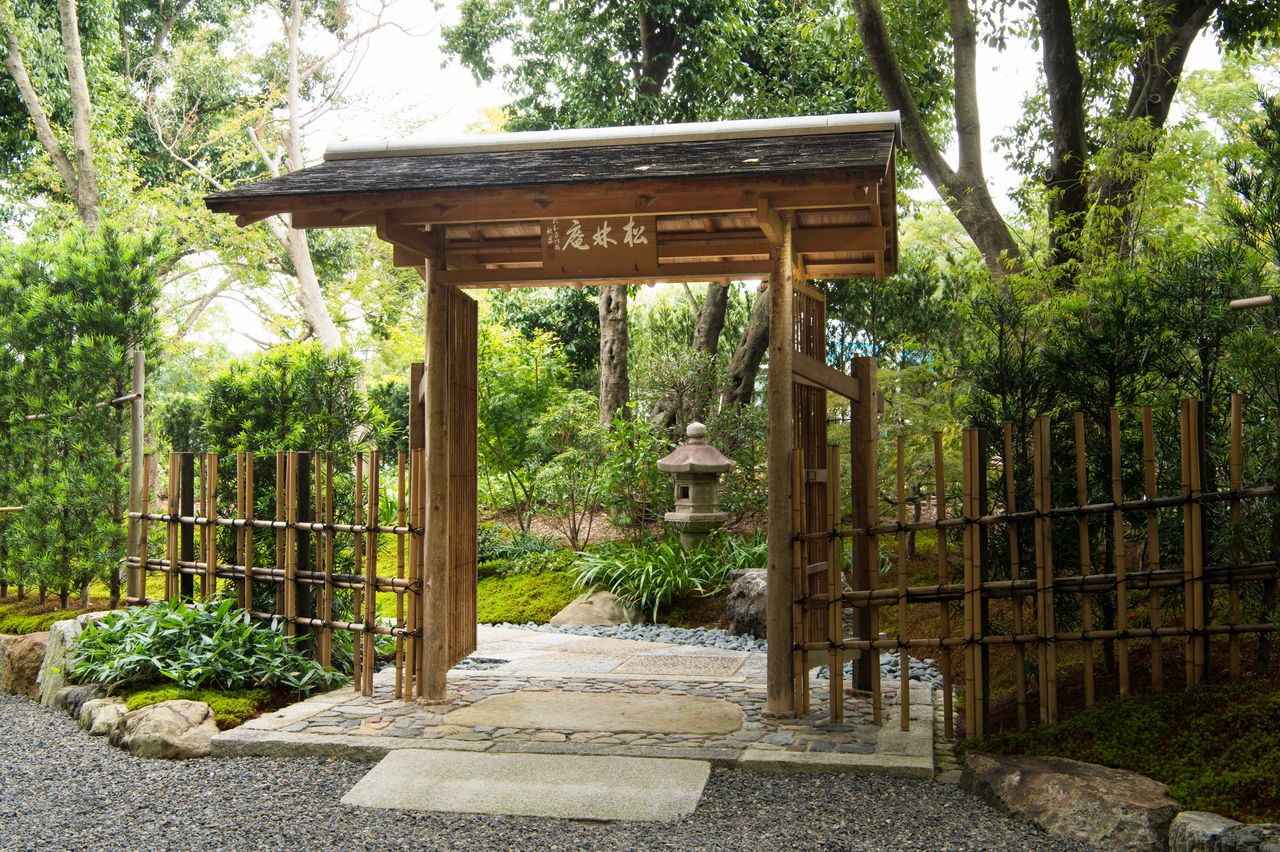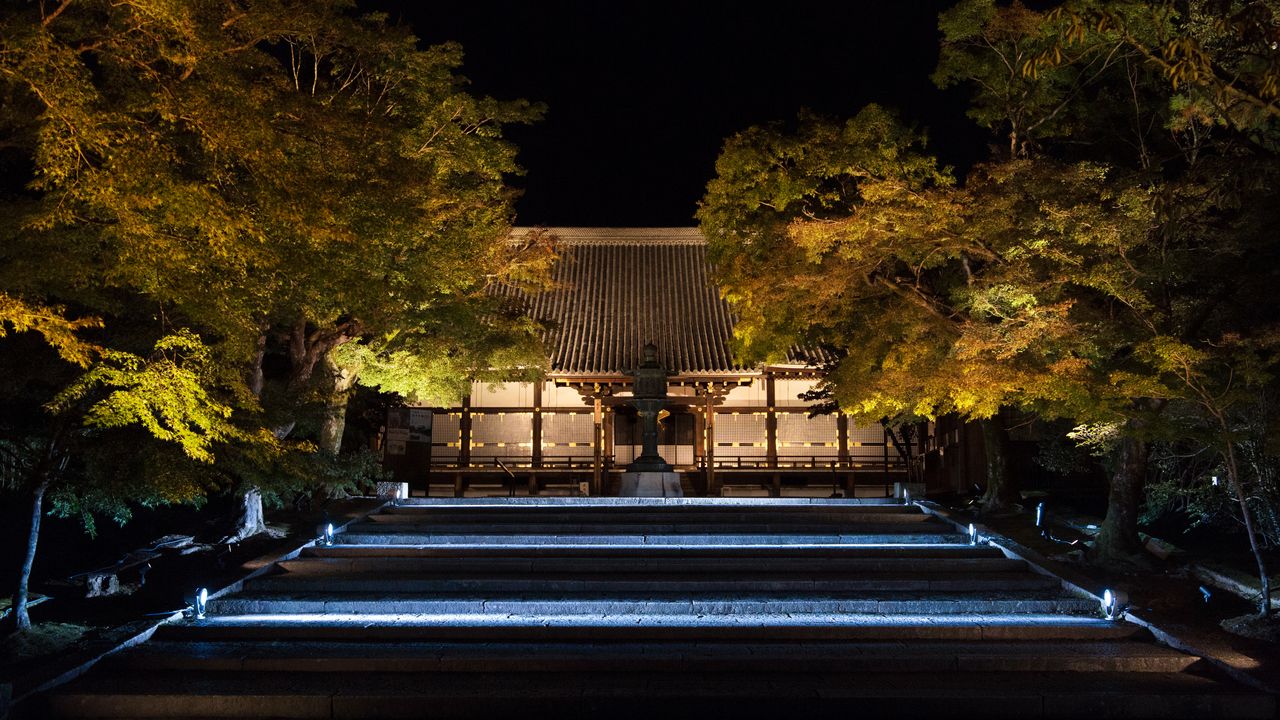
The Million Yen Temple Experience: Kyoto’s Ninnaji
Guideto Japan
Travel- English
- 日本語
- 简体字
- 繁體字
- Français
- Español
- العربية
- Русский
In the spring of 2018, the Kyoto temple Ninnaji announced its entry into the tourist lodging industry with a single, and singularly expensive, plan: a ¥1 million per night package. Targeting mainly affluent tourists from abroad, the plan accommodates one party of up to five people per day. Charges for meals are extra.
Ninnaji, which offers this unique experience, was founded by Emperor Uda (866–931) in 888. It is the head temple of the Omuro school of Buddhism’s Shingon sect. The emperor, taking religious vows upon his retirement from the throne in 897, had an omuro (residence) built on the temple grounds. It is because of this structure that the temple is also known as Omuro-gosho, the Omuro imperial residence. Over the following centuries, members of imperial lineage served as head priests of the temple. Due to this close connection to the imperial family and the nobility, Ninnaji became the most prestigious of the former imperial temples. In 1994, the temple was designated part of the Historic Monuments of Ancient Kyoto, a UNESCO World Heritage Site.
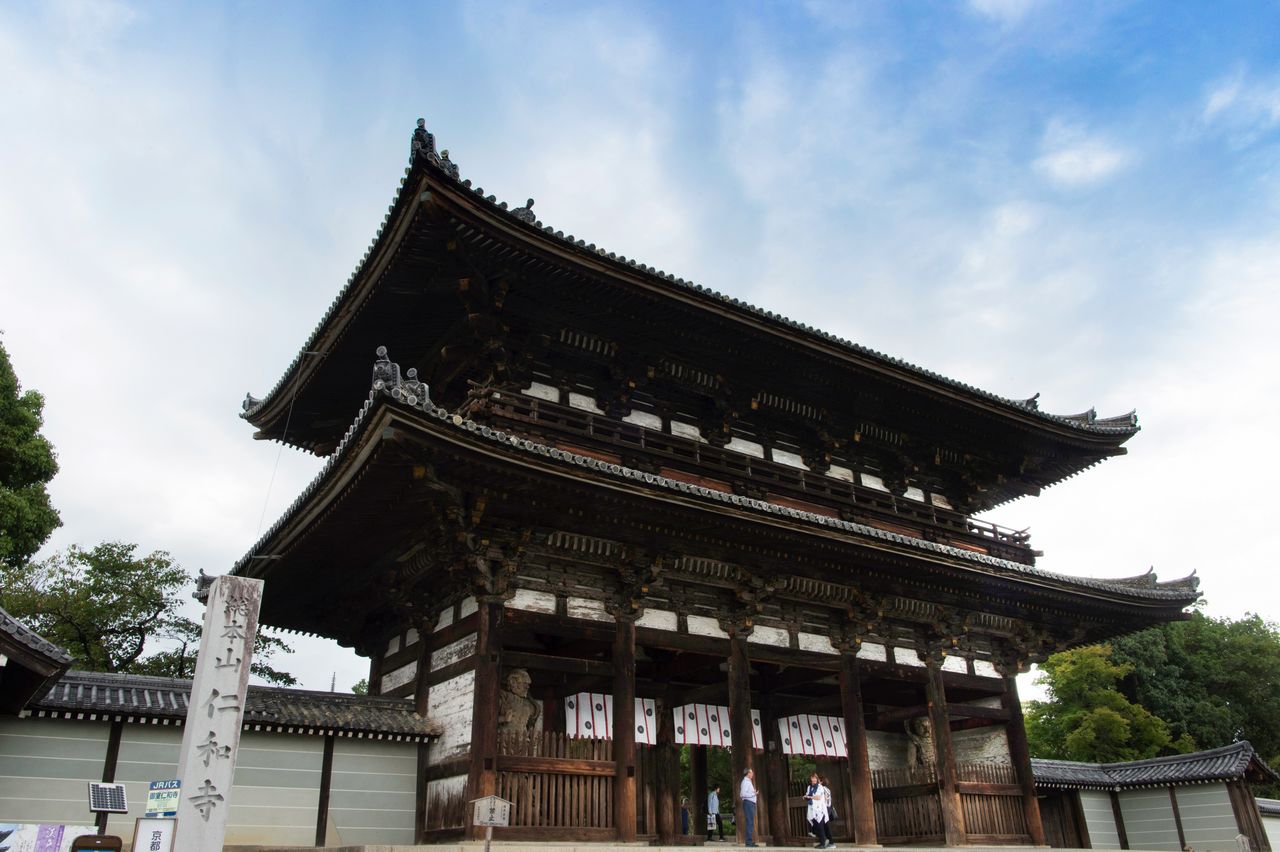
The Niōmon is an important cultural property. Soaring 18.7 meters high, it is the imposing entrance to Ninnaji.
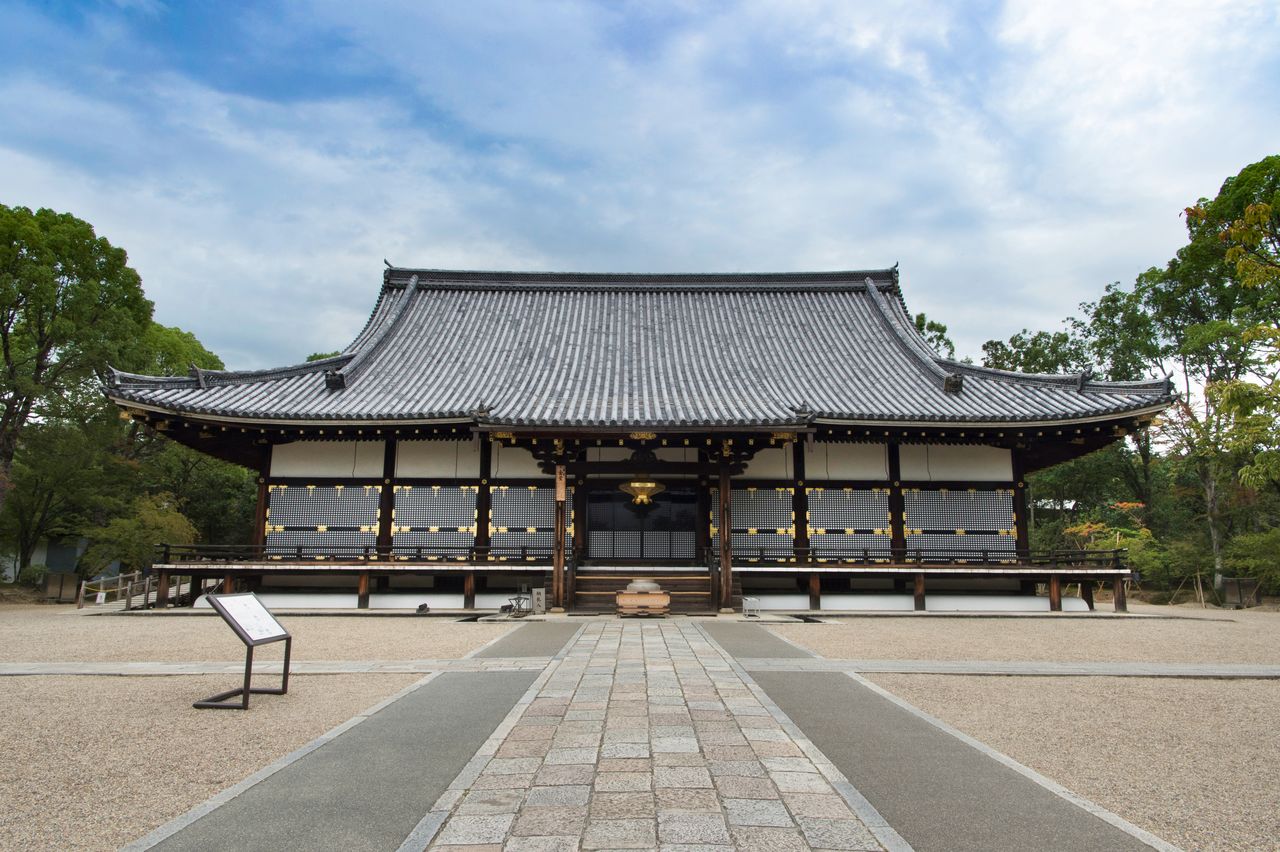
The principal figure in the Kondō Hall is a statue of Amitabha (Amida). The Seiden and the Shishinden, structures designated national treasures, were moved to Ninnaji during the Kan’ei period (1624–44).
Kanazaki Gishin, who is responsible for property management at Ninnaji, says “The 1 million yen charge isn’t simply for accommodation. Our guests’ stay at Ninnaji is intended to be an immersive cultural experience. We refurbished Shōrin’an, where guests stay, to meet the comfort expectations of the wealthy individuals we welcome. Once the temple gates are closed to the general public for the day, our guests can enjoy the atmosphere of Ninnaji undisturbed until the next morning.”
Guests have the temple grounds of this World Heritage site all to themselves for the night, allowing them to indulge in a unique cultural experience. We set out to find out more.
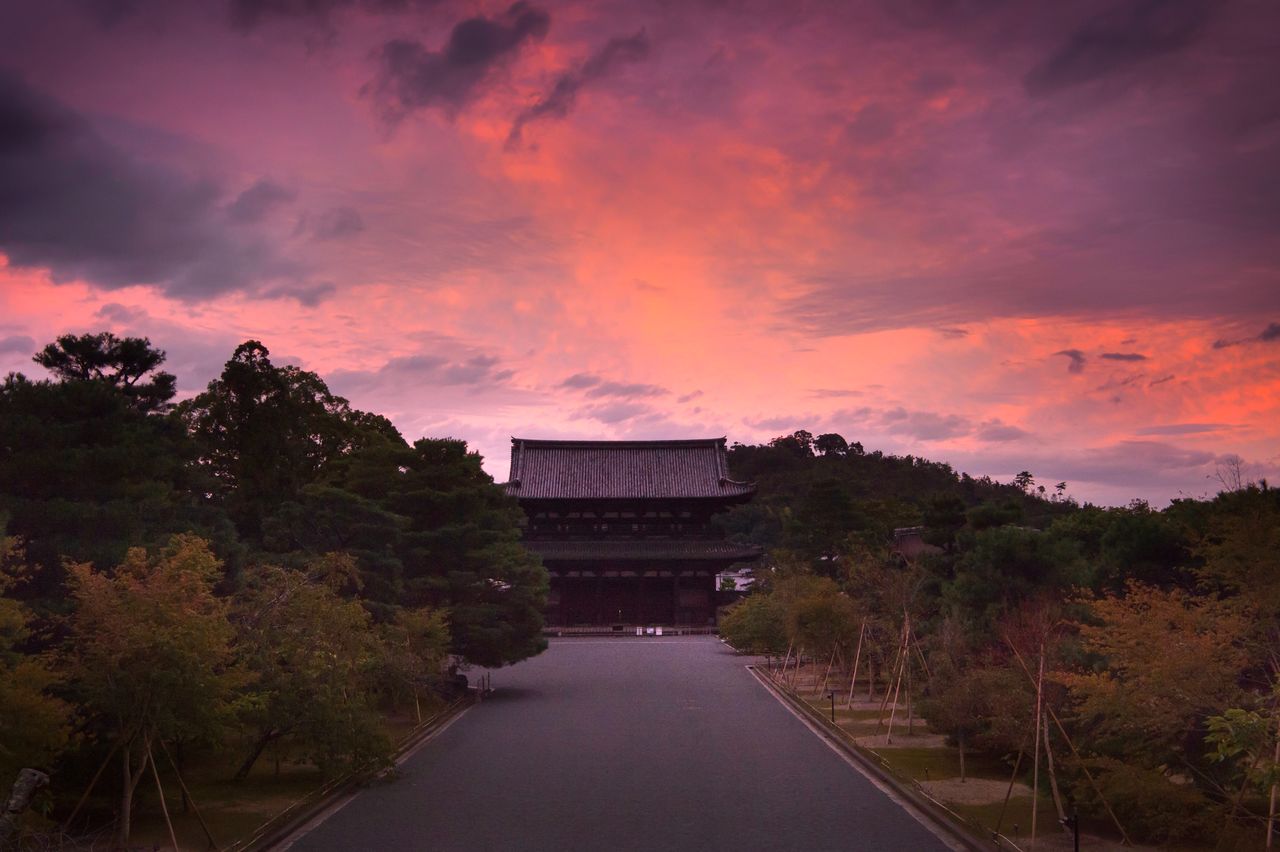
The Niōmon Gate has closed and all visitors have left. Guests can enjoy this spectacular sunset all to themselves.
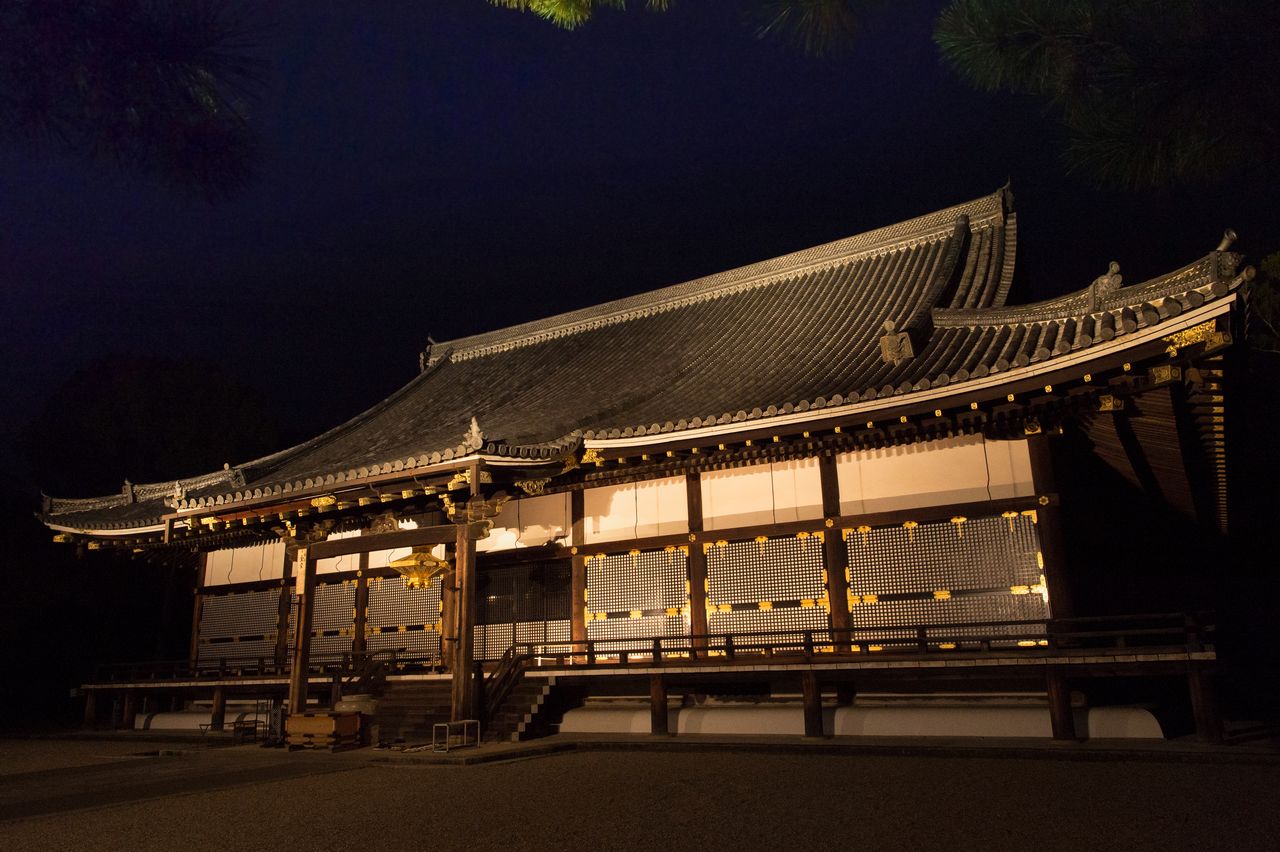
A close-up view of the Kondō Hall, illuminated for the evening, is a special experience.
Temples as Japanese Culture Centers
Many historic structures, beginning with the Kondō Hall, a national treasure, can be found in the vast grounds of Ninnaji. Its buildings house Buddhist statuary and paintings and objects associated with the imperial family. The temple’s gardens and natural surroundings are also stunning, and the famous omuro-zakura, cherry trees that bloom late in the season, are a popular springtime attraction.
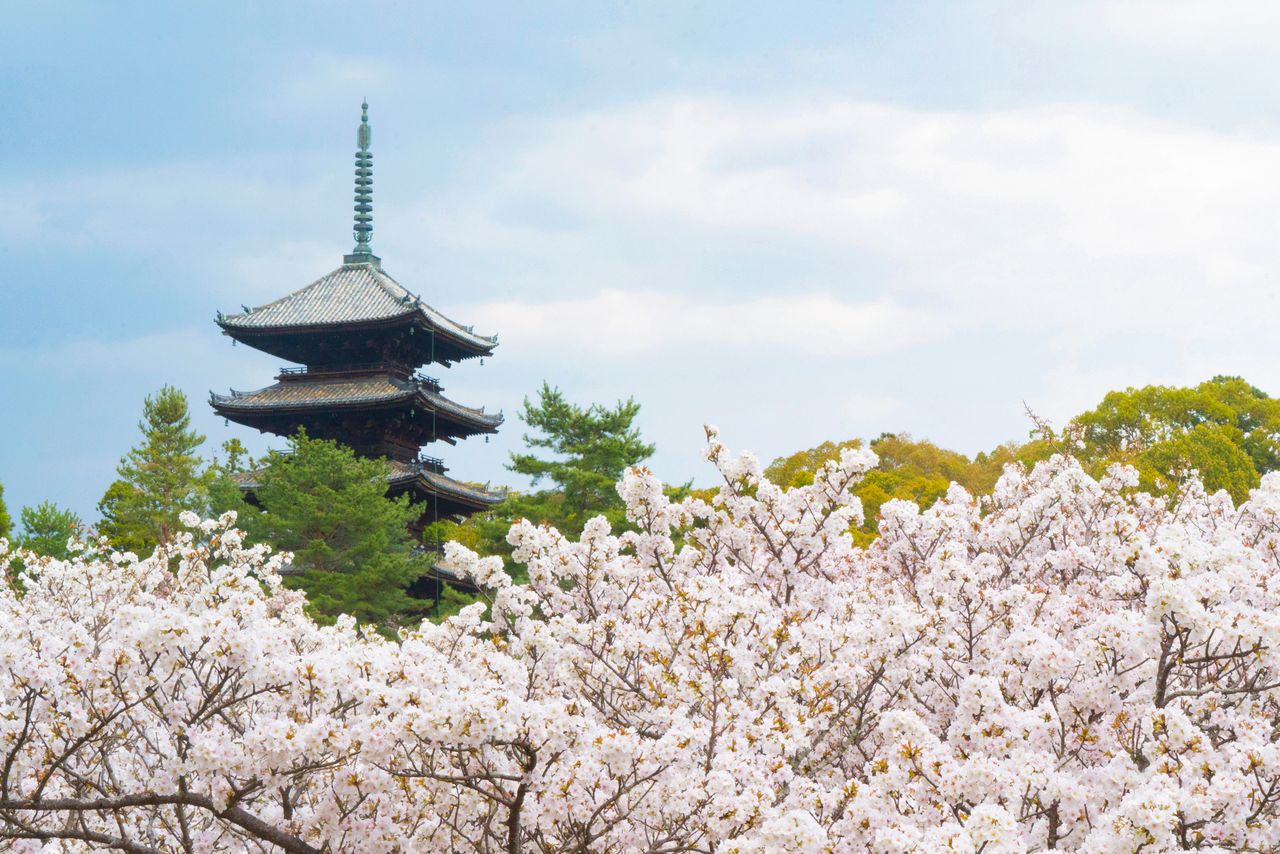
The omuro-zakura of Ninnaji bloom late, closing out the cherry blossom season. The temple’s five-story pagoda, an important cultural property, provides a picturesque backdrop.
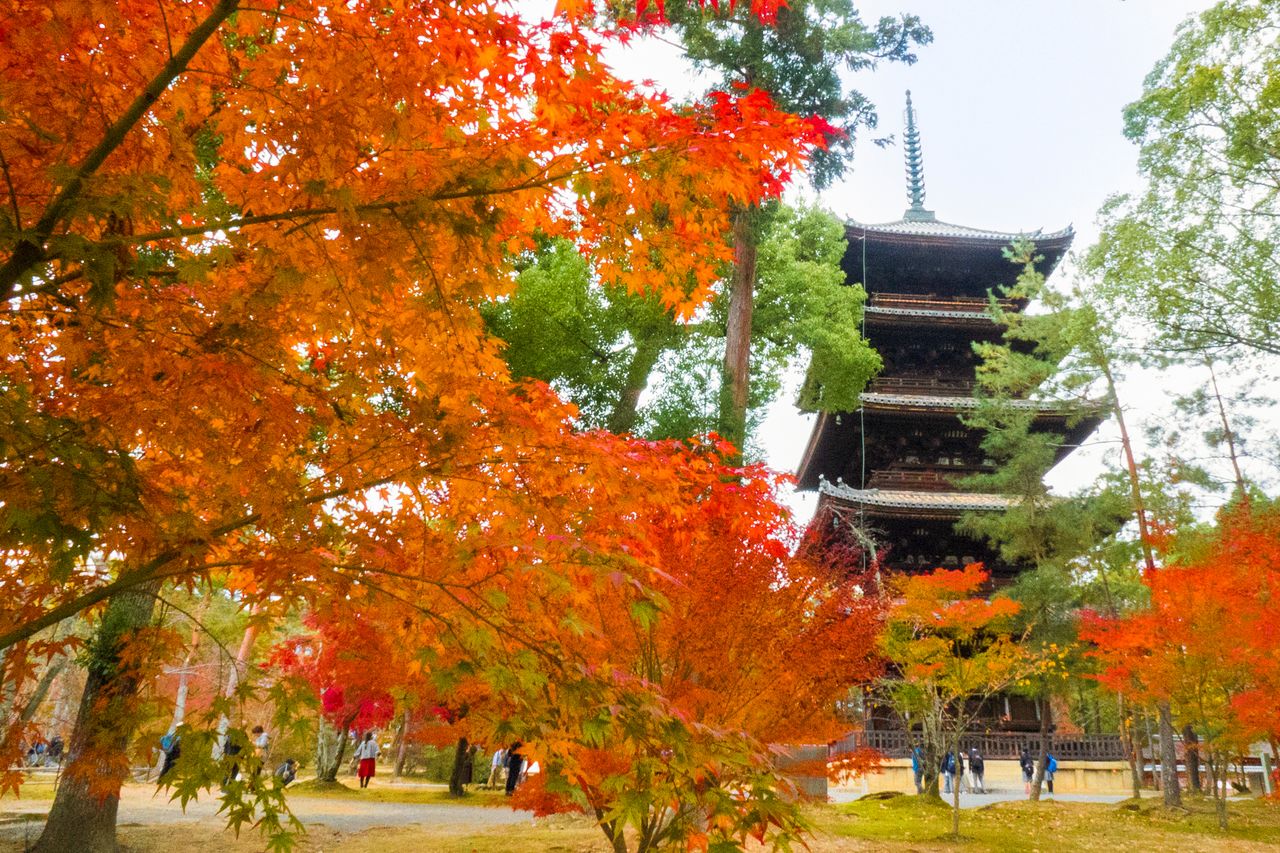
In autumn, the fiery colors of maples add atmosphere to Ninnaji.
Kanazaki says, “Temples were formerly centers for creating and disseminating culture. Today, it’s our responsibility to continue passing down Japan’s culture to younger people. In recent years, the temple has also been receiving more and more visitors from abroad, so I believe it’s our role to introduce our culture not only in Japan, but all around the world.”
Building a museum or other new facility to introduce Japanese culture would be a costly undertaking, so Kanazaki believes that the temple should take advantage of its surroundings to display its treasures, all the while taking care to preserve the buildings in its care.
Temples have played an important role in perpetuating Japan’s cultural legacy. The buildings are testament to the skills of miyadaiku, specialists in the construction of shrines and temples. Sculptors, some well-known, others whose names have been lost in the mists of time, created the statuary found in temples throughout the country. Renowned painters and their apprentices decorated interior walls and partitions with images on religious or natural themes. Temples also hosted cultural pursuits ranging from tea ceremonies, flower viewing, and moon viewing to poetry contests. In particular, Ninnaji, given its background as an imperial temple, served as a gathering place for high-ranking personages and literati of the Heian period (794–1185). Even up through the Edo period (1603–1868), the district around the temple was home to many artists and cultural figures. Needless to say, Ninnaji was also a religious entity that attracted the faithful. There may really be no better setting for experiencing Japanese culture to the full than Ninnaji.
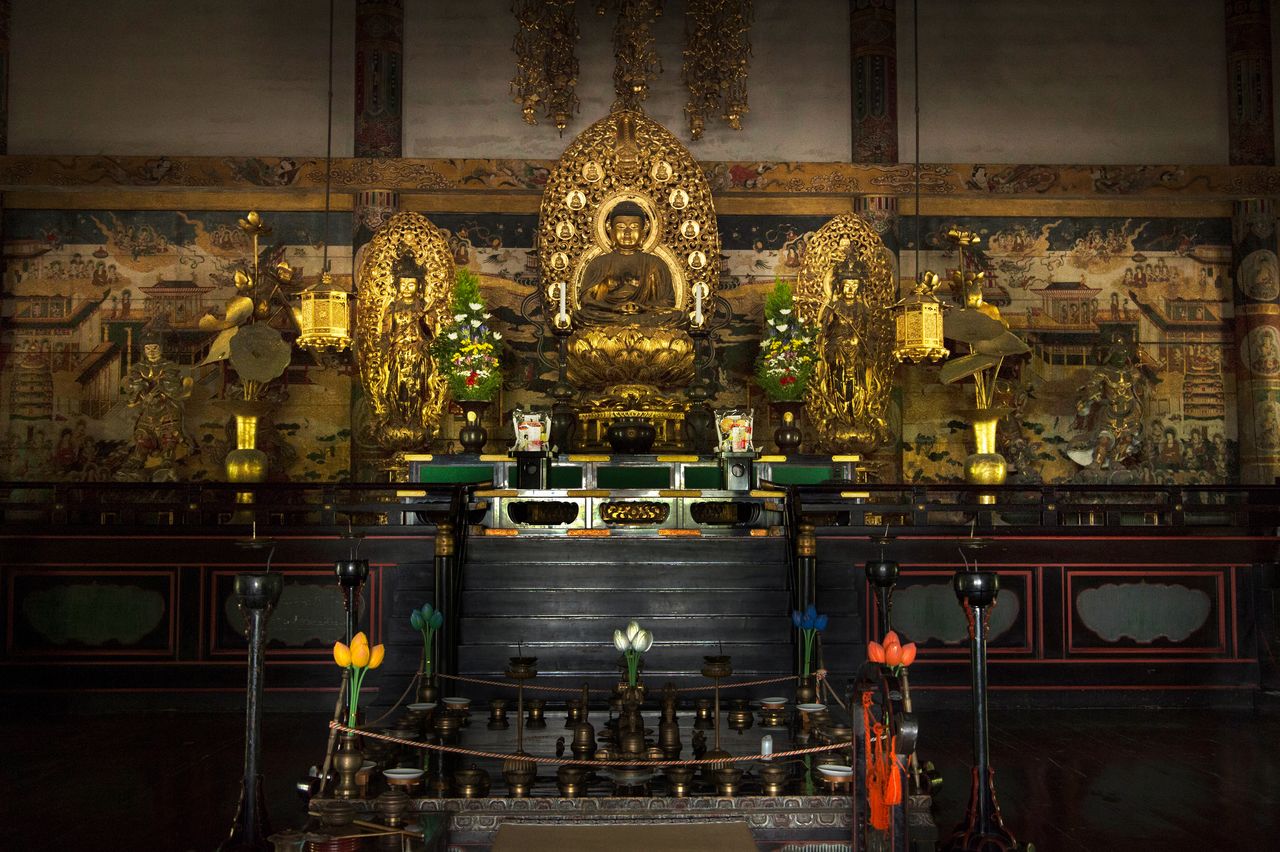
A figure of Amitabha (Amida), flanked by Avalokitesvara (Kannon) on the left and Mahasthamaprapta (Daiseishi Bosatsu) on the right, is the principal figure in the Kondō Hall.
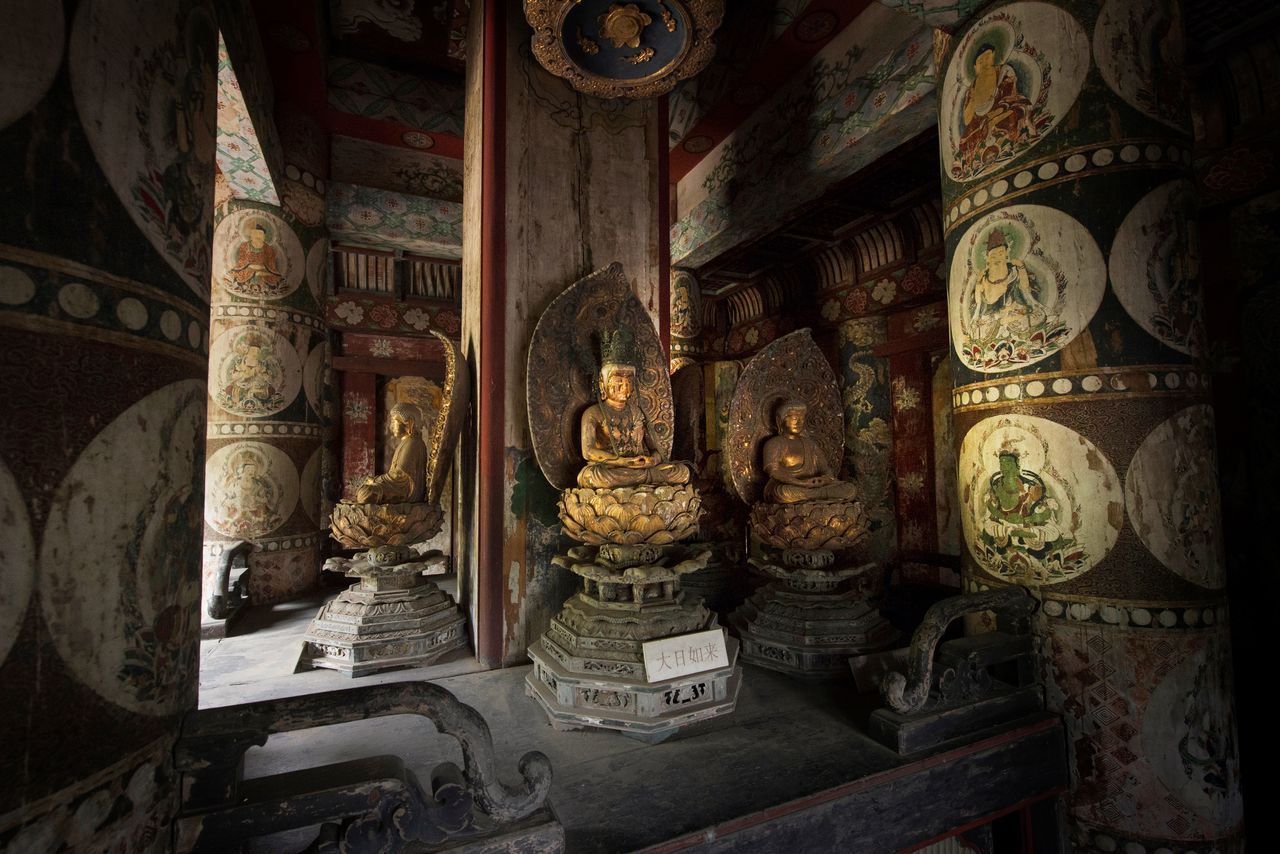
The inside of the pagoda, normally closed to the public, can be viewed by the overnight guests. The central figure here is Vairocana (Dainichi Nyorai).
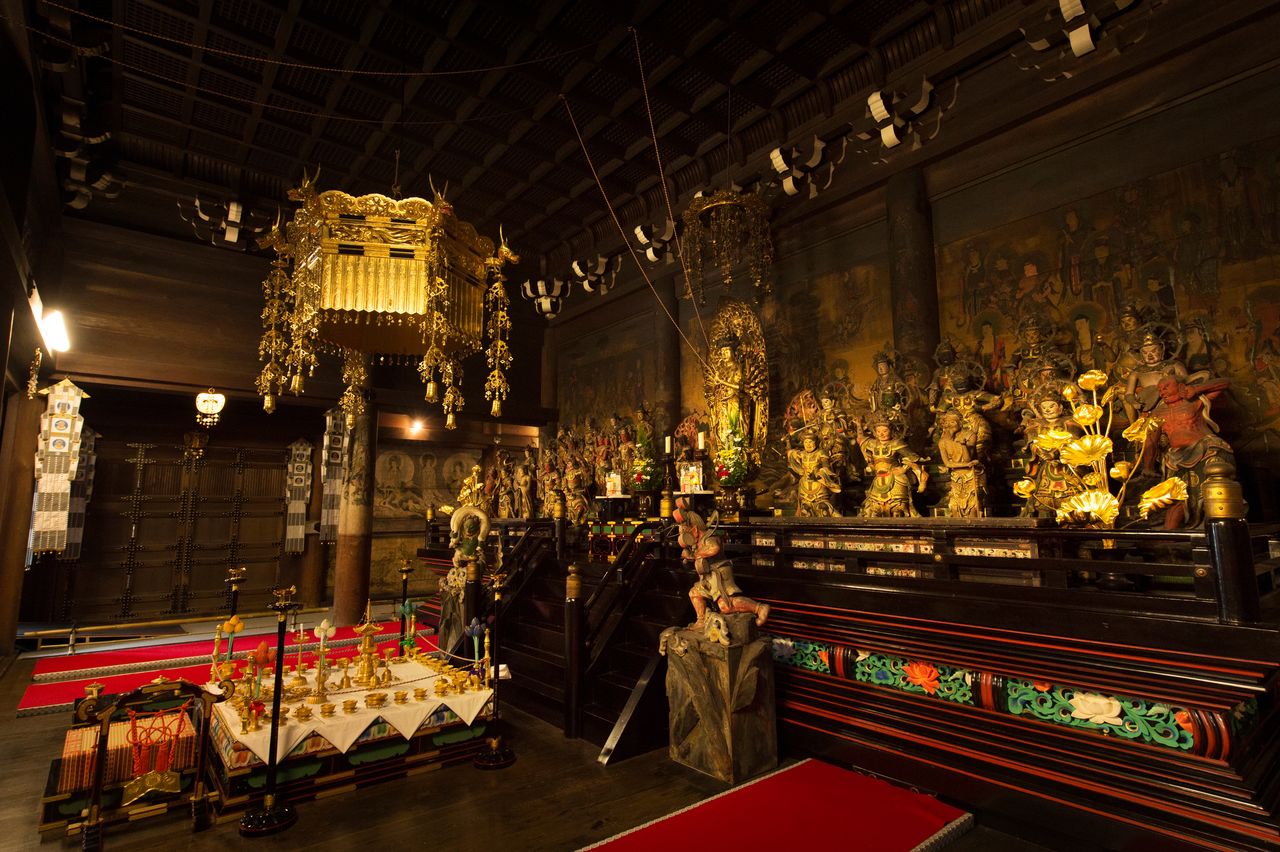
The Kannon Hall recently completed a six-year refurbishment. This is where the priests’ religious practice takes place, and the hall is normally not open to the public.
A Stay at a World Heritage Site
Once the temple gate has closed for the day, guests can stroll around the grounds, escorted by a priest who serves as a guide. The place is deserted, and they can visit buildings and view temple treasures that are not normally accessible to the public.

Guests take a private tour of the grounds, which at nighttime are suffused in a mysterious atmosphere.
Dinner is served in the main Shinden Hall of the temple complex, and guests often have breakfast in one of the temple’s tea rooms. As head priest Segawa Taishū explains when he greets guests, they are in the imperial residence’s main building, where rites and ceremonies take place, and there are two tea rooms on the grounds. One is Hitōtei, which Emperor Kōkaku (1771–1840) played a role in designing. The other is Ryōkakutei, which was moved to Ninnaji from the home of Ogata Kenzan (1663–1743) because his older brother, the famed Rinpa school painter Ogata Kōrin (1658–1716), took a fancy to it. Both structures are important cultural properties.
Guests can request specific culinary or cultural experiences ahead of time. For example, they may want to view a gagaku performance or an ikebana demonstration while dining on shōjin ryōri vegetarian temple cuisine. Ninnaji is a repository for many historical documents, so guests can also request entertainment re-creating a specific historical event. These flourishes are available for an additional fee, and Kyoto being synonymous with the ability to provide custom-made experiences, everything possible will be done to fulfill guests’ requests.
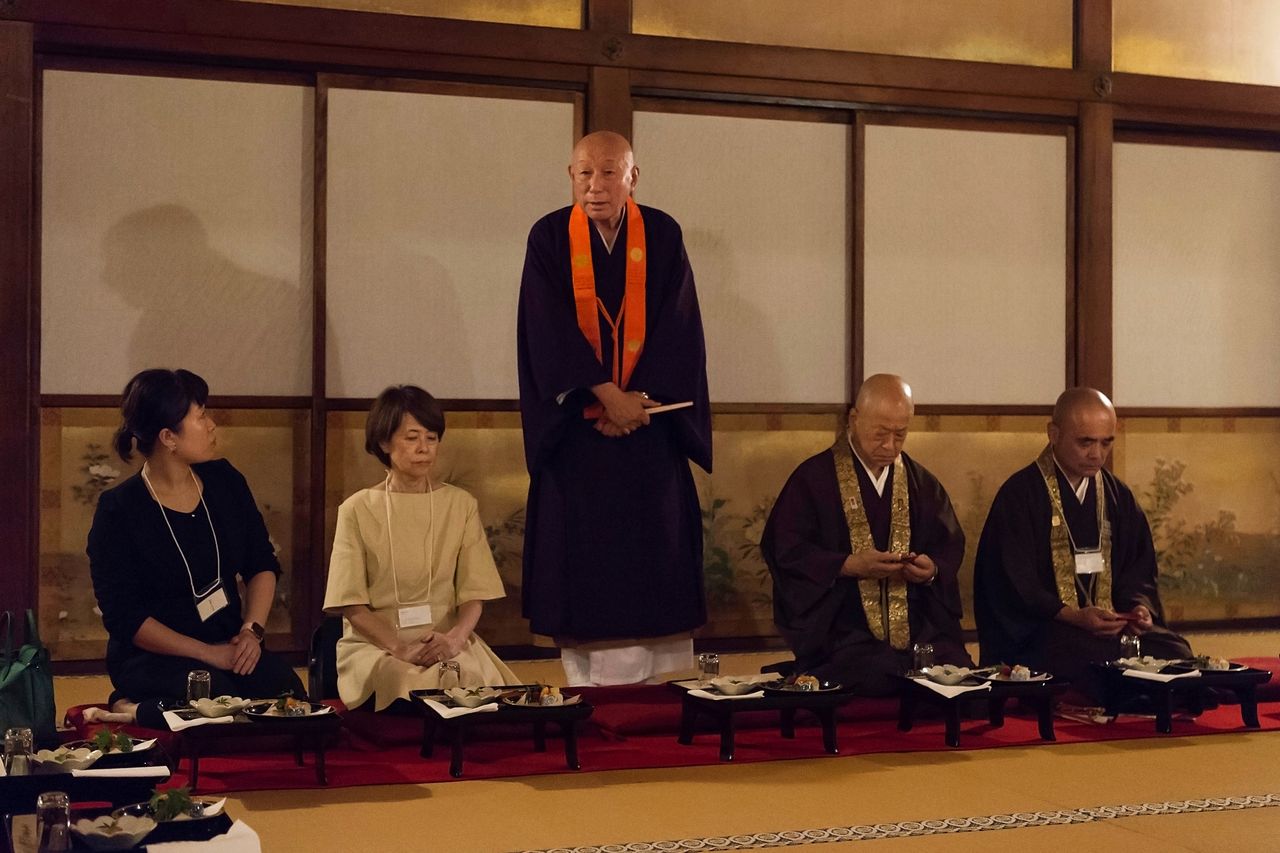
Head priest Segawa Taishū addresses guests before dinner in the Shinden Hall.
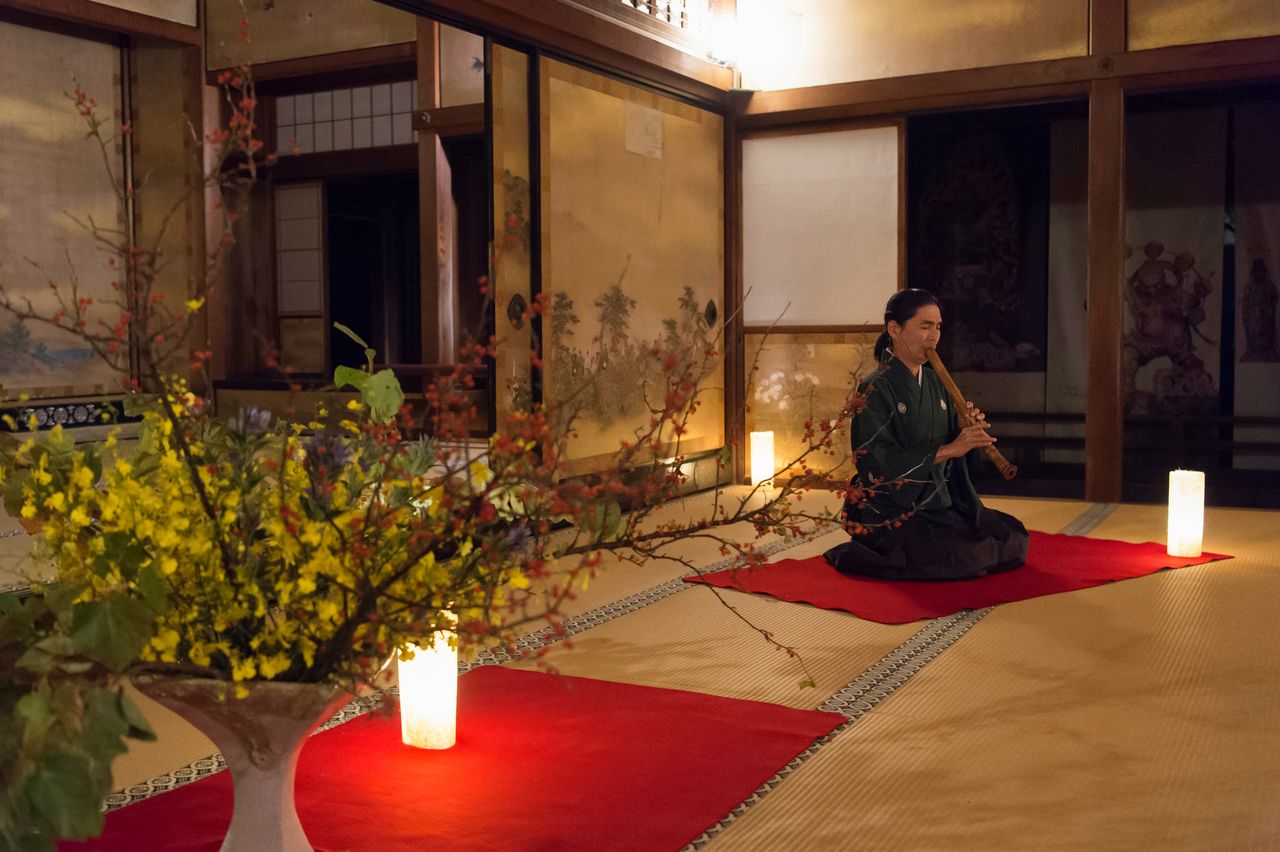
Flower arrangements of the Omuro school of ikebana add a touch of color in the Shinden Hall, where guests can dine to the sounds of gagaku imperial court music and shakuhachi bamboo flute.
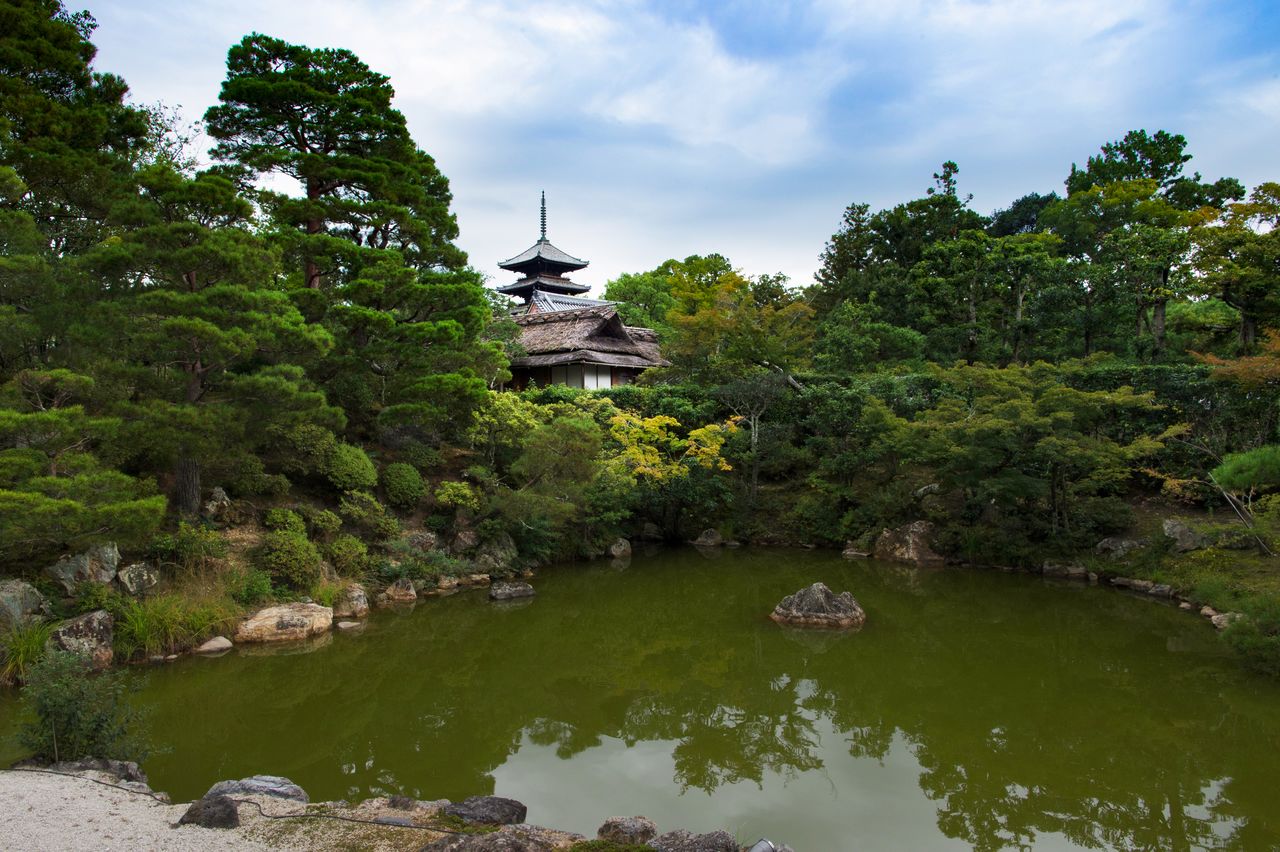
Hitōtei, near the pagoda, is the site for tea ceremonies and the morning meal.
Memorable cultural experiences await overnight guests. They can opt for a candlelit moon-viewing session in the South Garden of the Goten imperial residence to the sound of priests chanting shōmyō. Just as temple founder Emperor Uda is recorded as having done, they can admire the autumn moon over the garden’s white sand with the traditional offerings of dango rice dumplings and susuki pampas grass. Alternatively, they can view the wall paintings in the temple buildings, with a guide providing commentary, or arrange a tea ceremony in the Hitōtei tea room, a venue favored by Emperor Kōkaku.
Naturally, it takes time to arrange and prepare these one-of-a-kind cultural experiences; the use of cultural assets and temple treasures also involves expense. Such experiences cannot be offered to everyone, so wealthy, influential individuals have been targeted in the hope that they will spread the word about their stay.
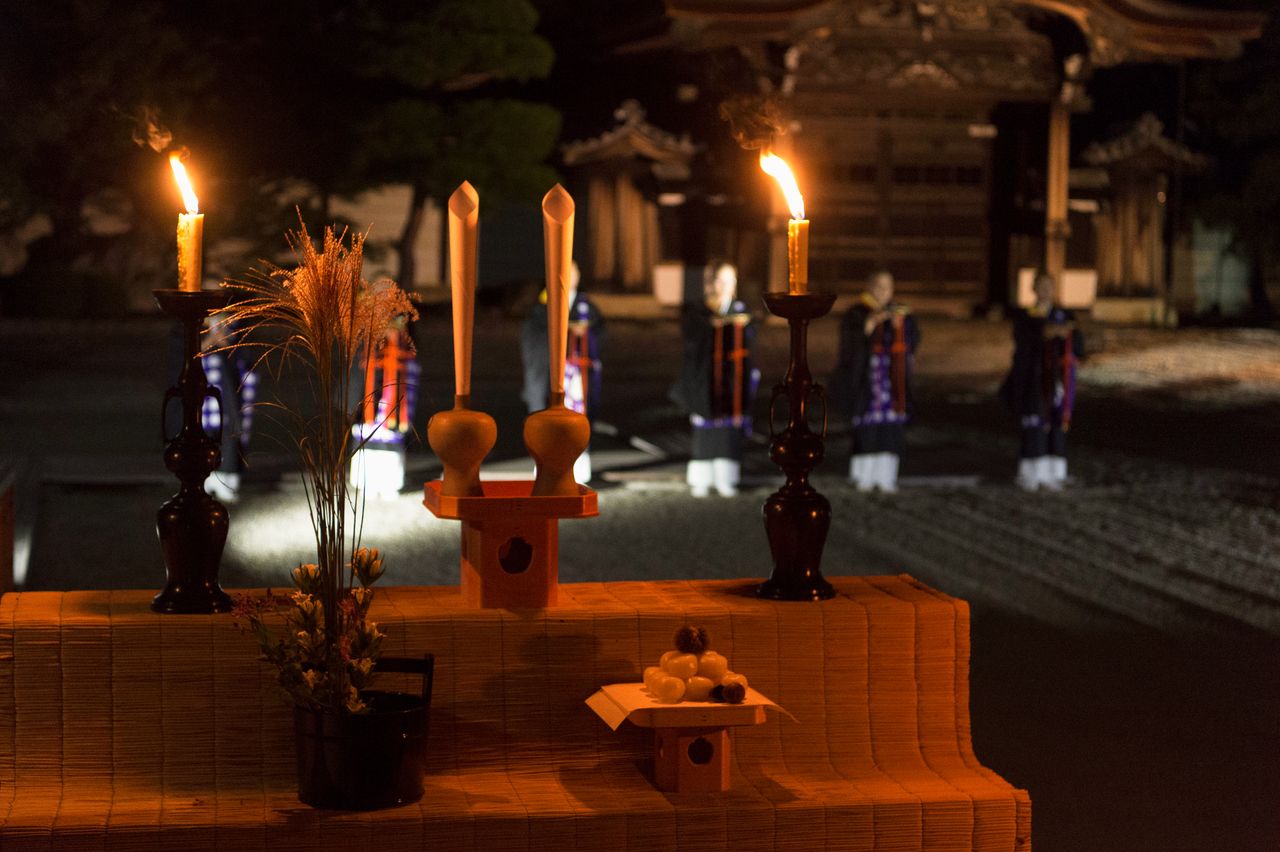
Moon viewing to the sound of priests’ chanting is an unparalleled experience that can savored to the full in a temple setting.
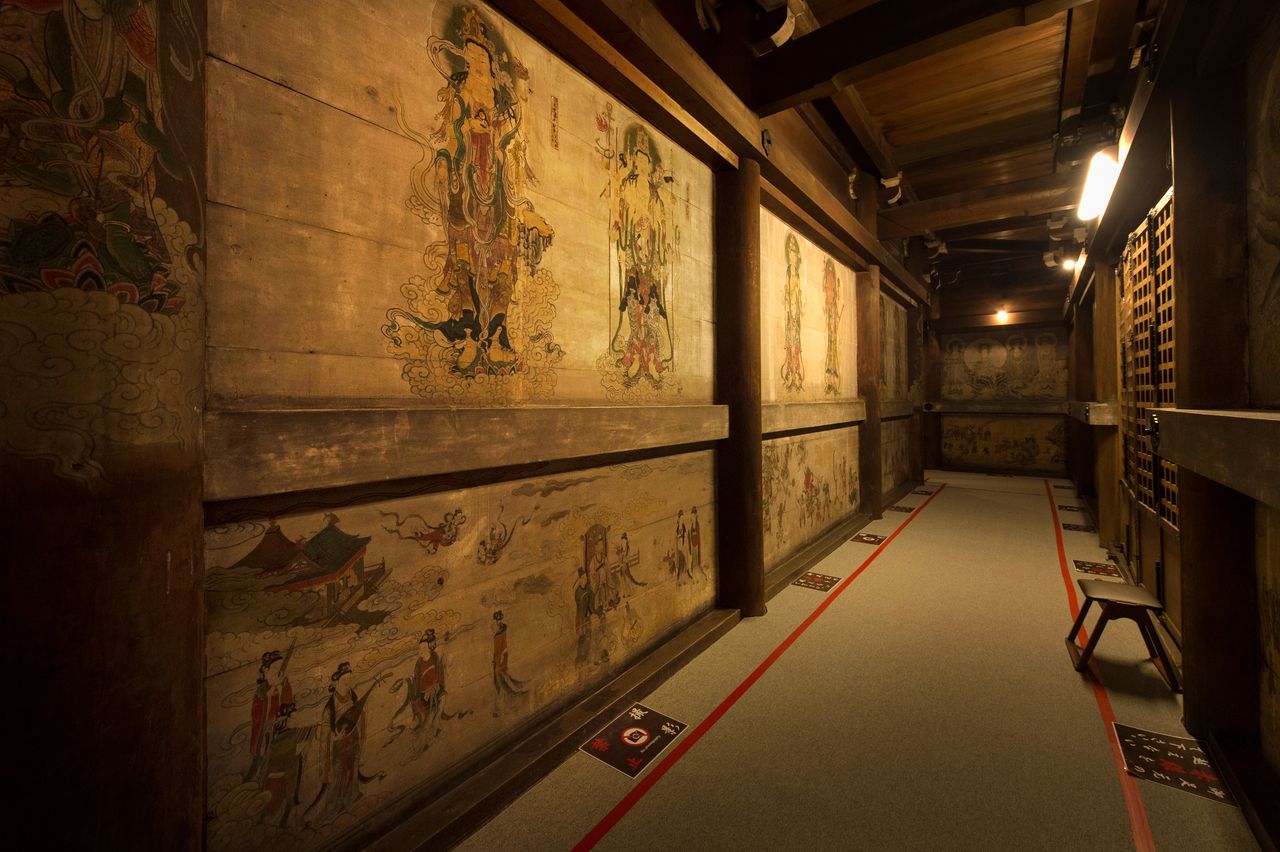
The wall paintings in the Kannon Hall, dating from the seventeenth century, are open to the public during special viewings only.
A Haven at Shōrin’an
The Nippon Foundation, whose Iroha Nihon program aims to communicate “the soul of Japan” through its culture, is the organization behind this innovative undertaking. Targeting mainly non-Japanese visitors with an interest in Japanese culture, the program arranges for them to stay at temples or other historic sites to enjoy an in-depth cultural experience. The foundation provides subsidies for refurbishing subtemples or other structures not open to the public for guest accommodation, limited to one party per site. It also supports the operation of the program, including public relations outreach. Part of the charges guests pay for their stay go toward preserving cultural assets and transmitting traditional skills.
Shōrin’an, where guests stay at Ninnaji, is the former residence of the Hisatomi family, whose members served as physicians and samurai attached to the temple. The structure was donated and moved to the temple grounds but fell into disrepair. To save the building, young staff members drew up a plan and applied to the Iroha Nihon program. In total, ¥157 million was spent refurbishing the building and sprucing up the garden, 80% of which was covered by a subsidy from the Nippon Foundation.
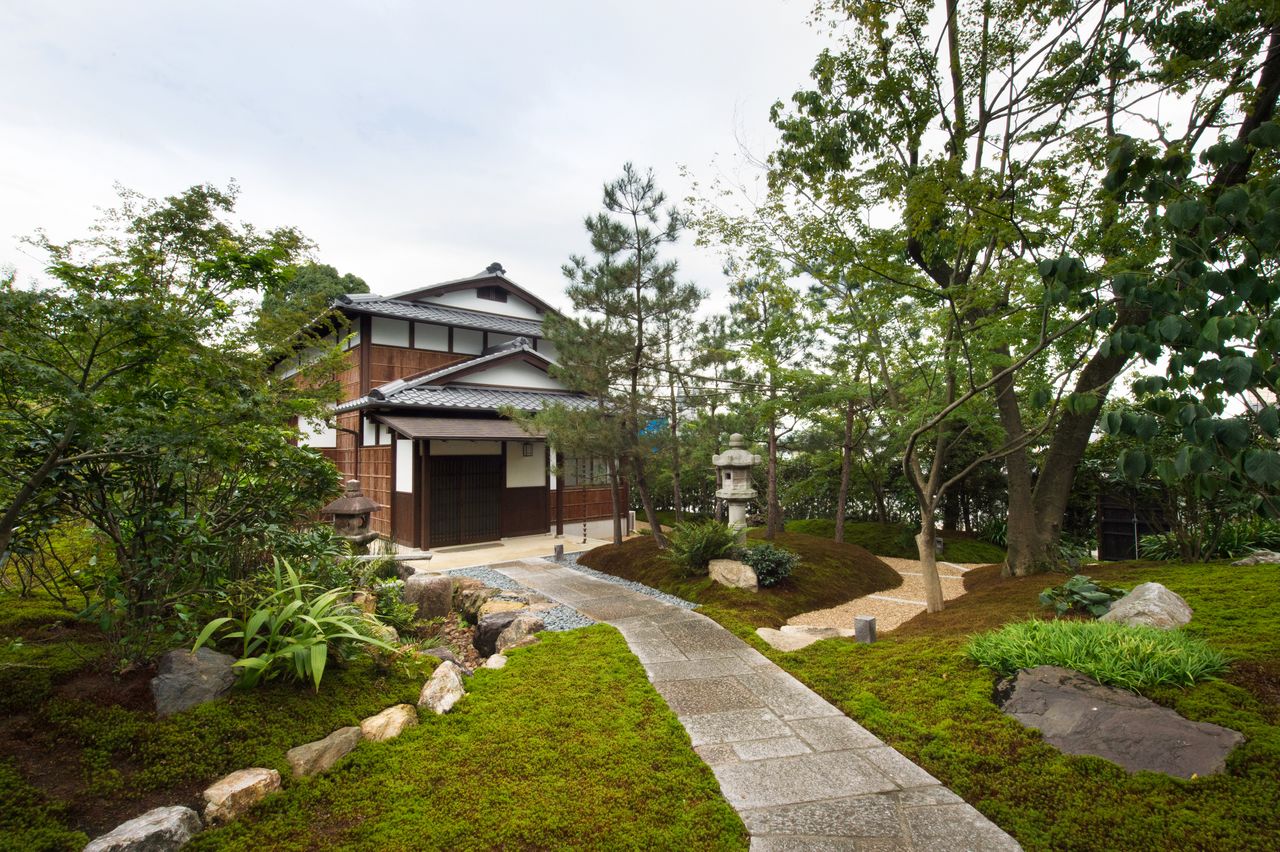
The two-story structure sits in an atmospheric Japanese garden.
At Shōrin’an, guests soak in a traditional Japanese bath and sleep on futon laid out on tatami flooring. The furniture and tableware, all made in Japan, have been chosen with care, and objects associated with the imperial family are on display.
Ninnaji property manager Kanazaki says, “Our guests are mainly wealthy people from abroad, including some whose names every Japanese would recognize. One visitor even said ‘I’d like to come again, so please build another cottage next to Shōrin’an.’ Some visit with their families and even bring their babysitter along.”
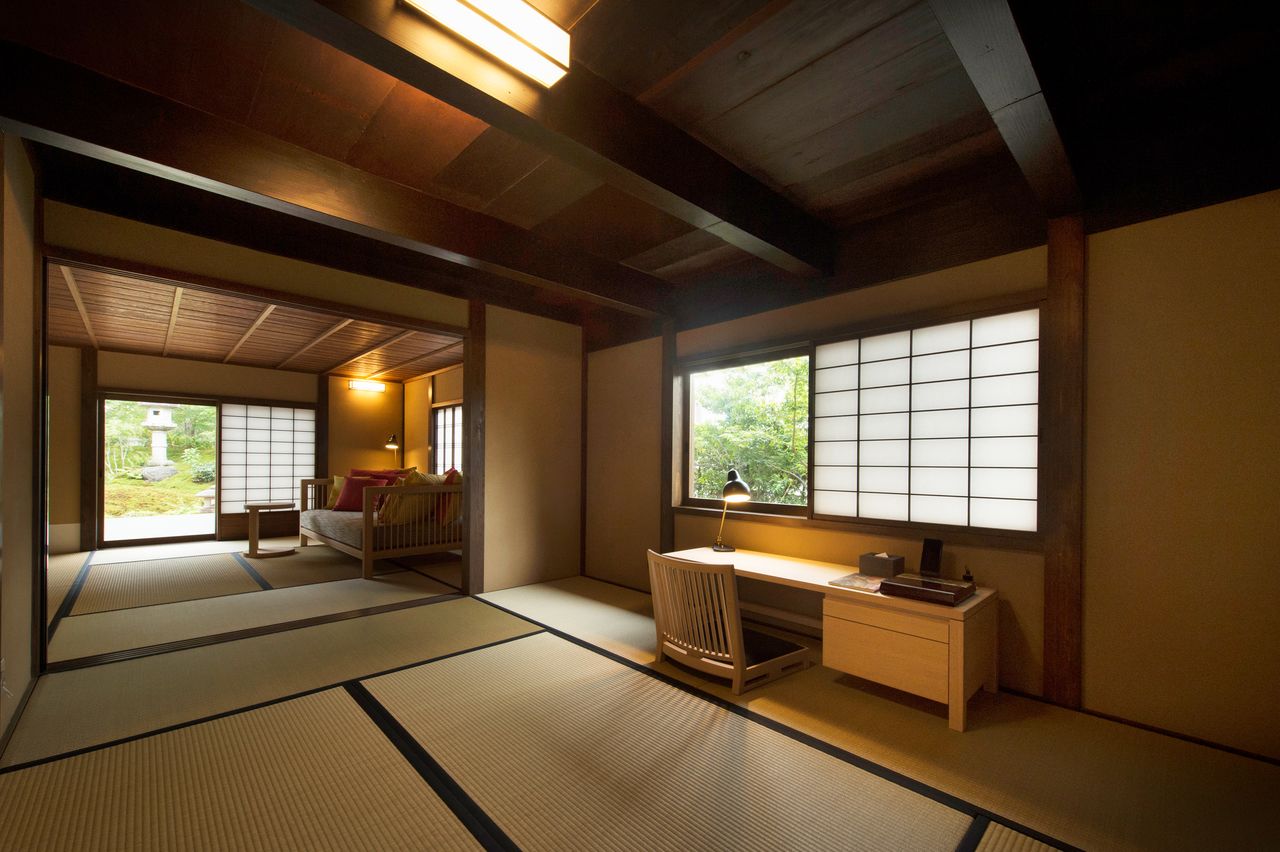
Guests sleep on futon in the rooms. Special attention has been lavished on the furniture, all of which is made in Japan.
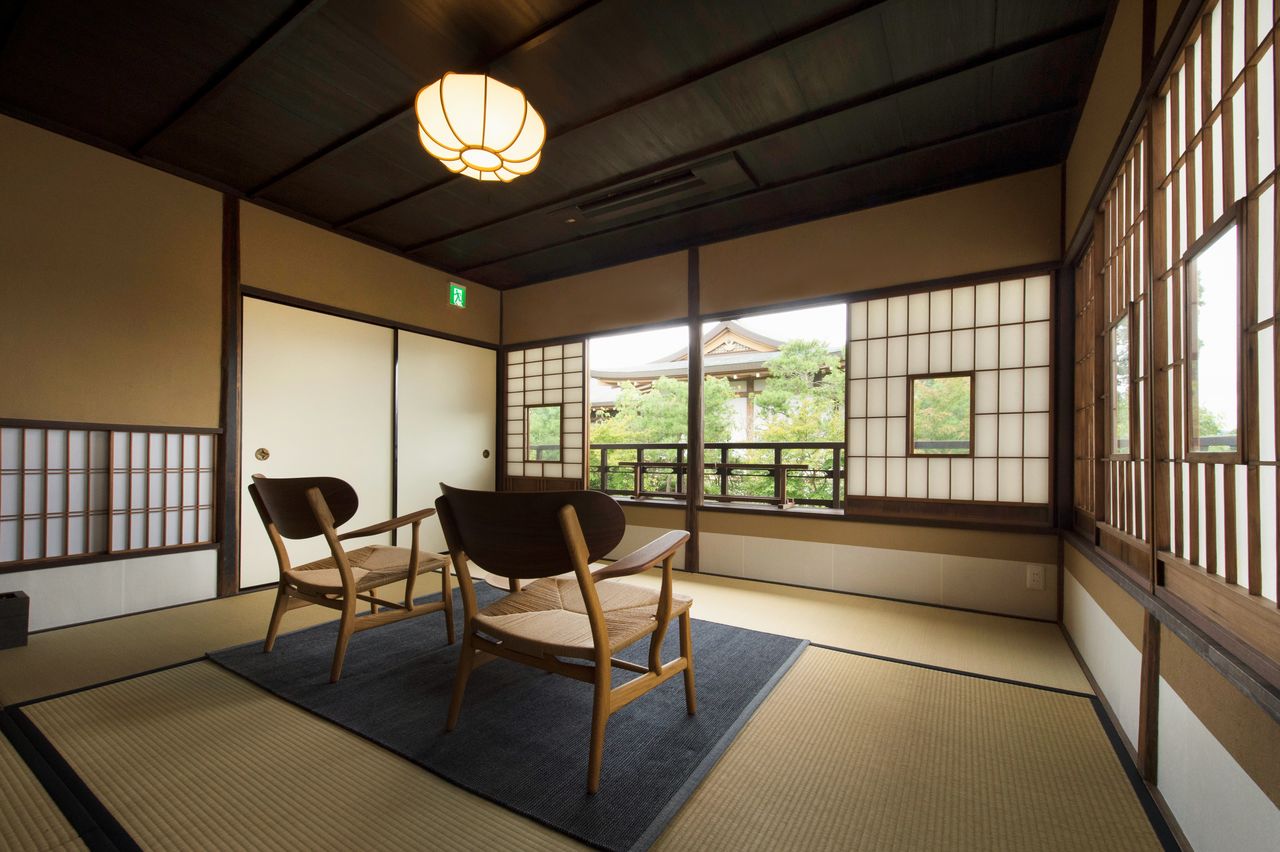
The garden can also be viewed from the second floor.
Shōrin’an can accommodate a party of up to five persons, but guests are free to invite friends or acquaintances to share the evening meal or take part in a tea ceremony. To experience temple life to the full, guests are encouraged to rise early and participate in the priests’ morning routine.
Japanese patrons can also enjoy this unique experience. Kanazaki relates that one family visited with their elderly mother. They wanted to create special memories for her and greatly enjoyed their visit. Kanazaki also suggests that a betrothal ceremony combined with a stay at Shōrin’an would be a memorable occasion for the two families to be joined in marriage.
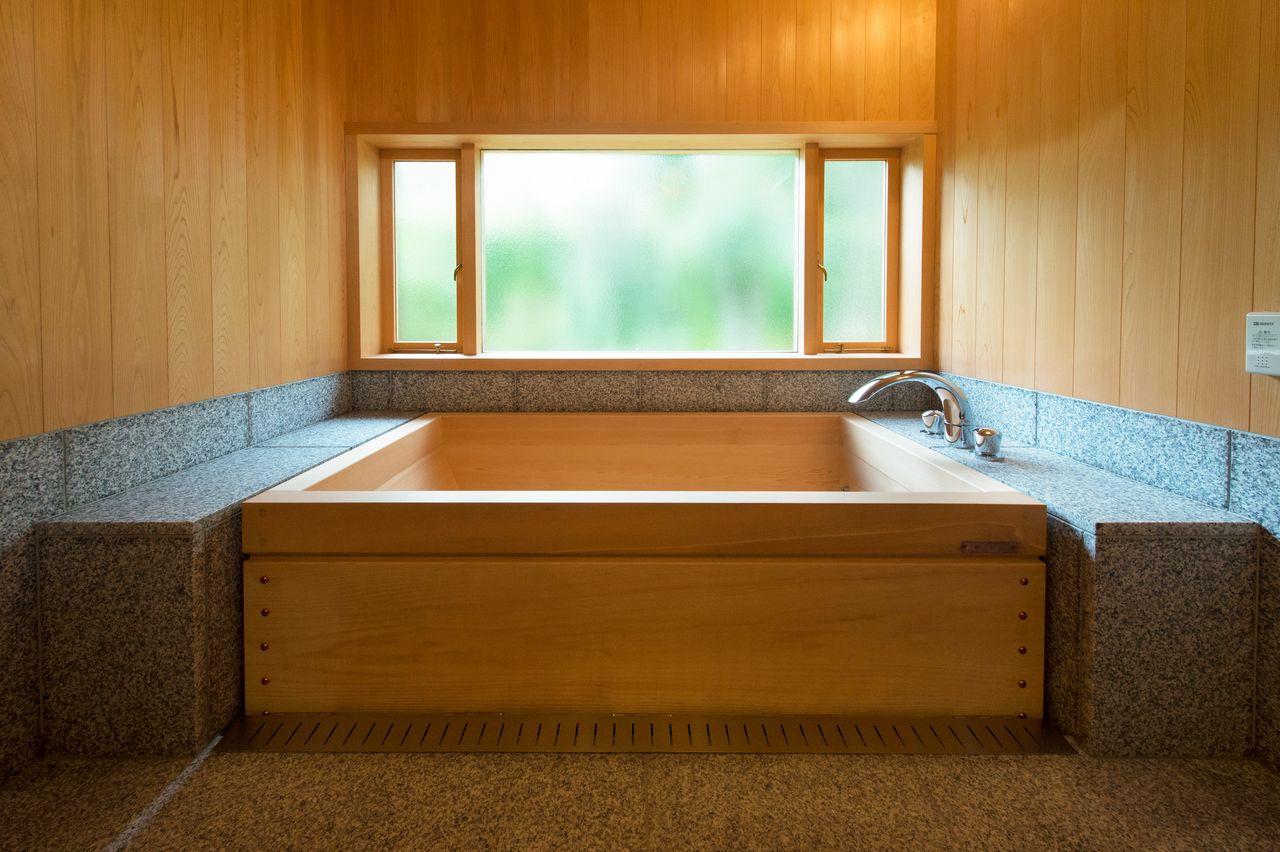
The traditional Japanese bath makes abundant use of wood.
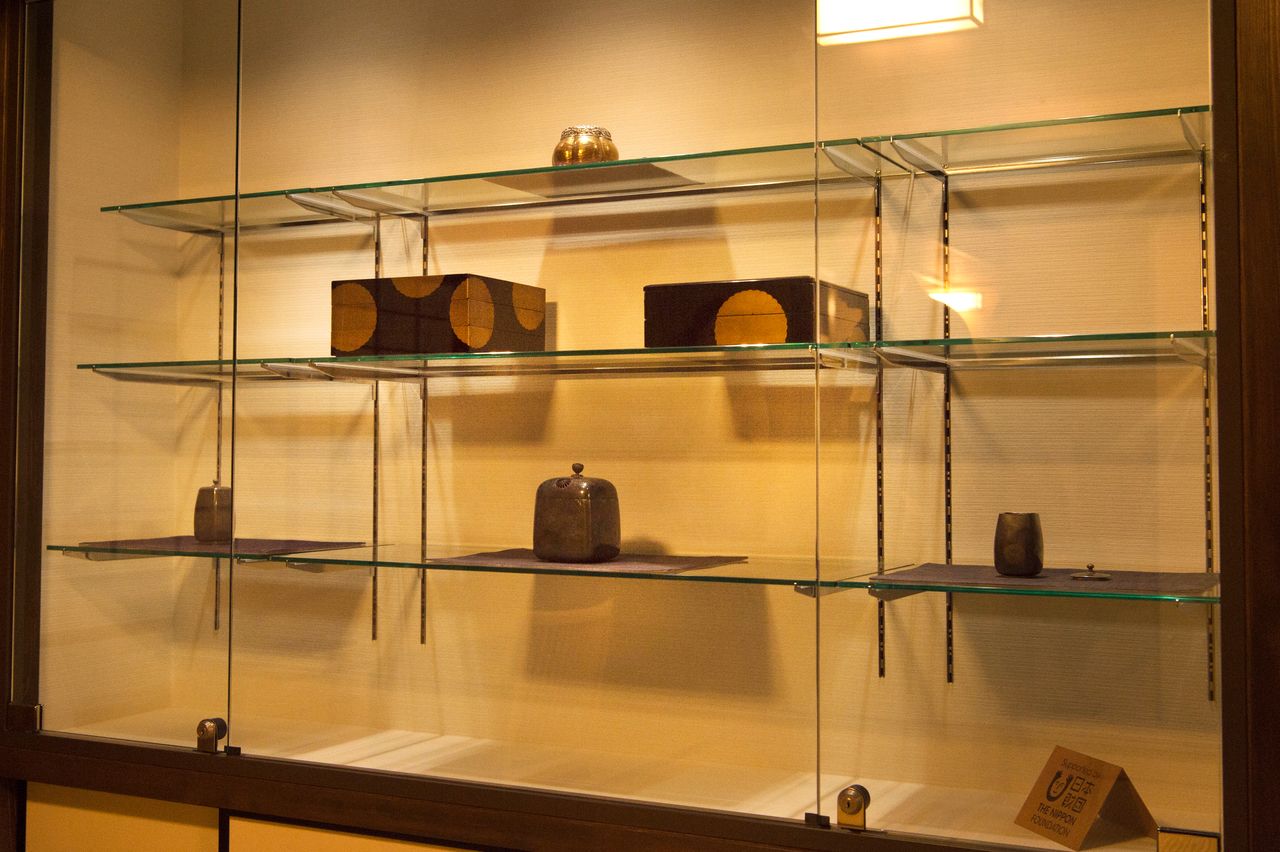
Temple treasures, including some objects associated with the imperial family, are displayed in a showcase.
A New Role for a Head Temple
The story about Ninnaji charging ¥1 million for an overnight stay made a splash and raised eyebrows in some quarters about a tax-exempt religious organization engaging in a taxable activity. Kanazaki is unfazed, though, admitting that “It was good publicity, as a matter of fact,” but emphasizing that the temple does pay tax on its for-profit operations.
And Ninnaji is not only for the rich. The temple has gradually been cutting its admission fee for those 16 and under since autumn 2018. Kyoto’s major temples earn substantial income from organized school tour groups, but Ninnaji has chosen to forgo that income to encourage support for Japan’s culture among the younger generation.
“We get many, many school groups, but the students usually just saunter through the grounds, to which admission is free. Many leave without visiting the temple buildings or special showings of cultural artifacts, for which there is an admission charge. By eliminating this fee for students, we hope to encourage youth to take an interest in our country’s long history and traditions. If our efforts manage to reach even one or two young people, I feel it will have been worth it. Although they may not attach particular significance to their visit to Ninnaji now, when they reach adulthood, they may feel that they’d like to visit again.”
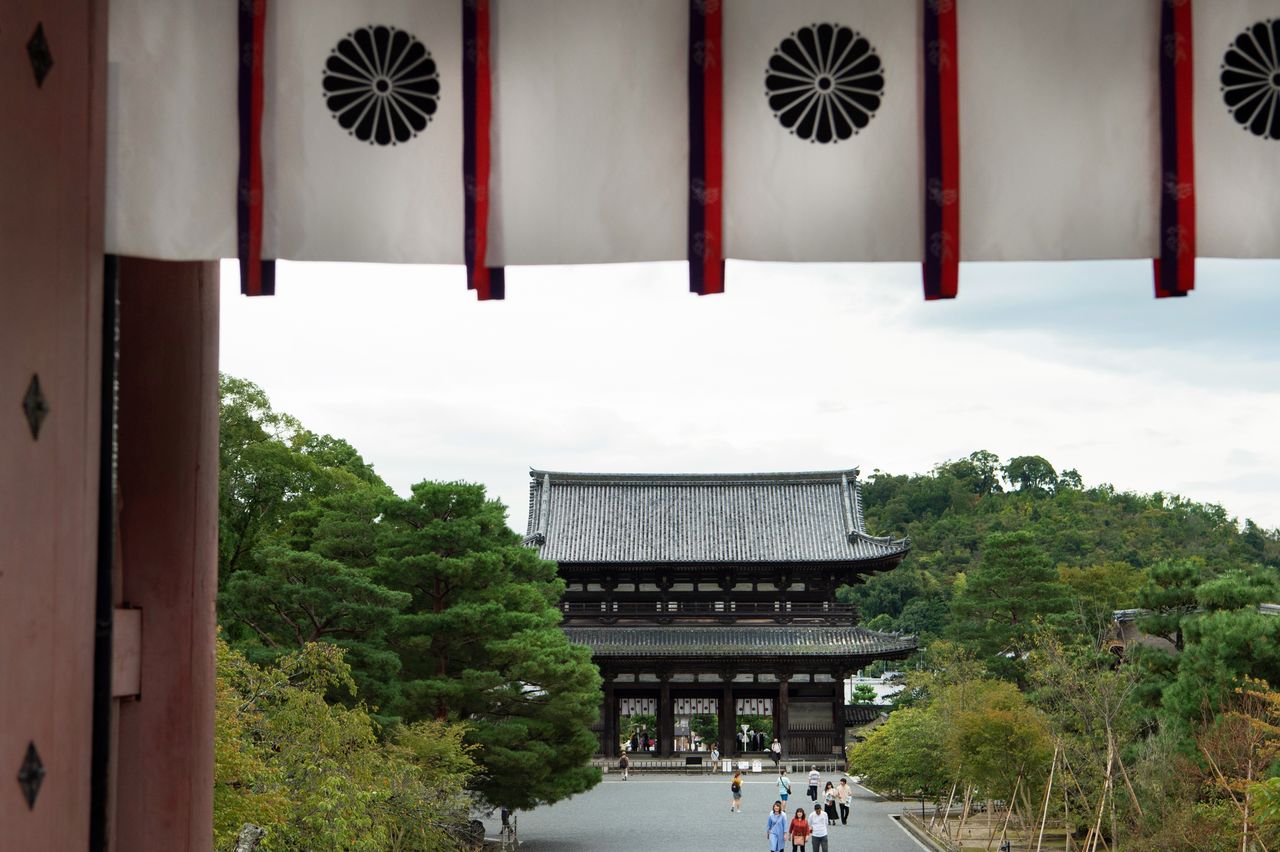
The chrysanthemum crest, symbol of the imperial family, appears on the short curtain across the top of the Niōmon Gate. Access to the grounds is free, but there is a fee for viewing the Goten imperial residence and the Reihōkan Treasure Hall and for special viewings.
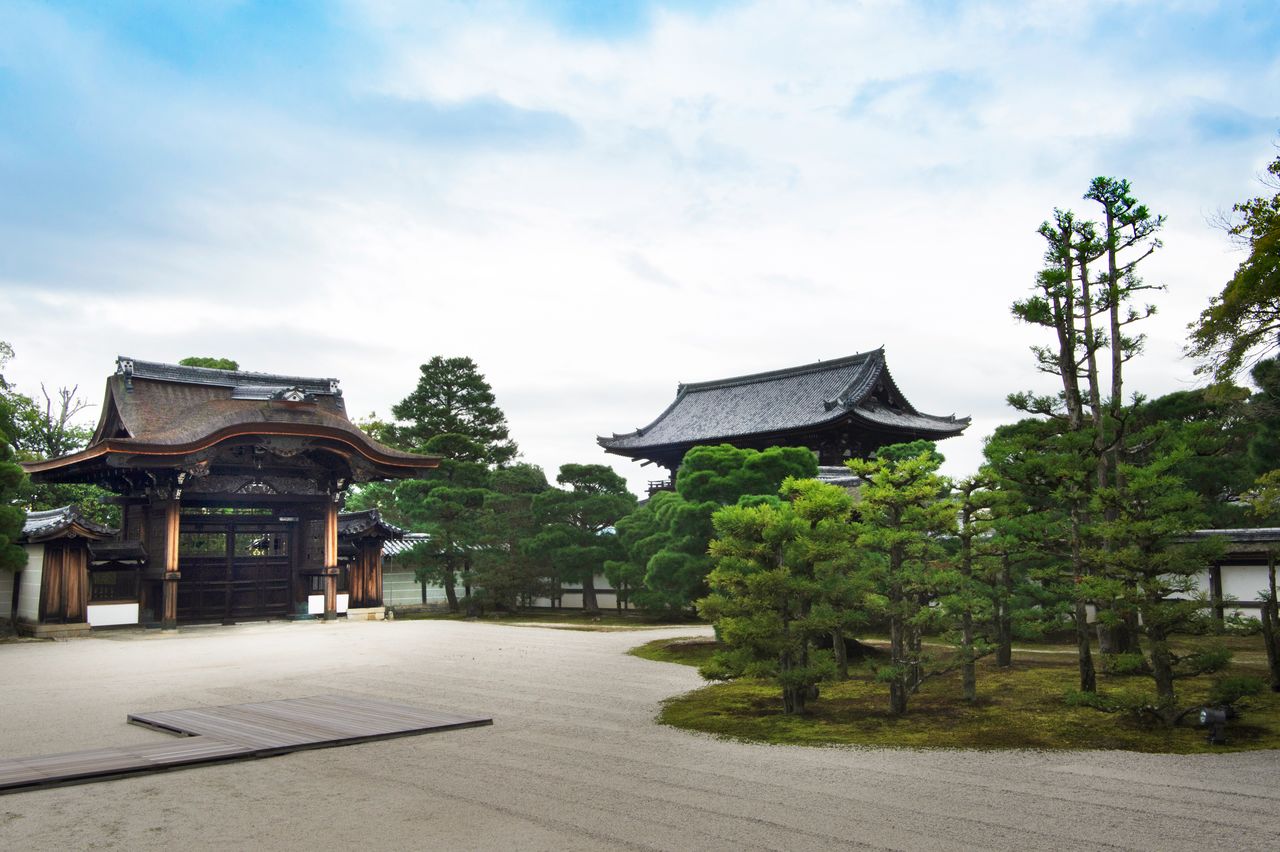
The South Garden of the Goten imperial residence and the Chokushimon Imperial Messenger Gate.
Ninnaji is also targeting new segments of the public to make itself better known. For example, it has collaborated with Kaiyōdo, a scale model maker, to create a figure of the temple’s principal figure—a seated statue of Amitabha classified as a national treasure—and has enlisted Tokyo Camera Club, which operates a popular online site for uploading photos, to design the lighting for the evening illumination of the temple grounds.
Kanazaki observes: “Temples have great difficulty maintaining their cultural assets and their estates. In addition to the structures on the grounds of the temple proper, Ninnaji has many venerable buildings and a vast amount of land, including the eighty-eight sacred places of Omuro, to take care of. We collect admission fees from people who come to view our designated cultural assets, but these represent fewer than 20 percent of the structures at Ninnaji, and this money has to pay for the maintenance and upkeep of the other 80 percent of the temple facilities as well. As the head temple of the Omuro school, we have to set an example for other temples, so we’ll continue exploring bold measures and making ourselves relevant in new ways.”
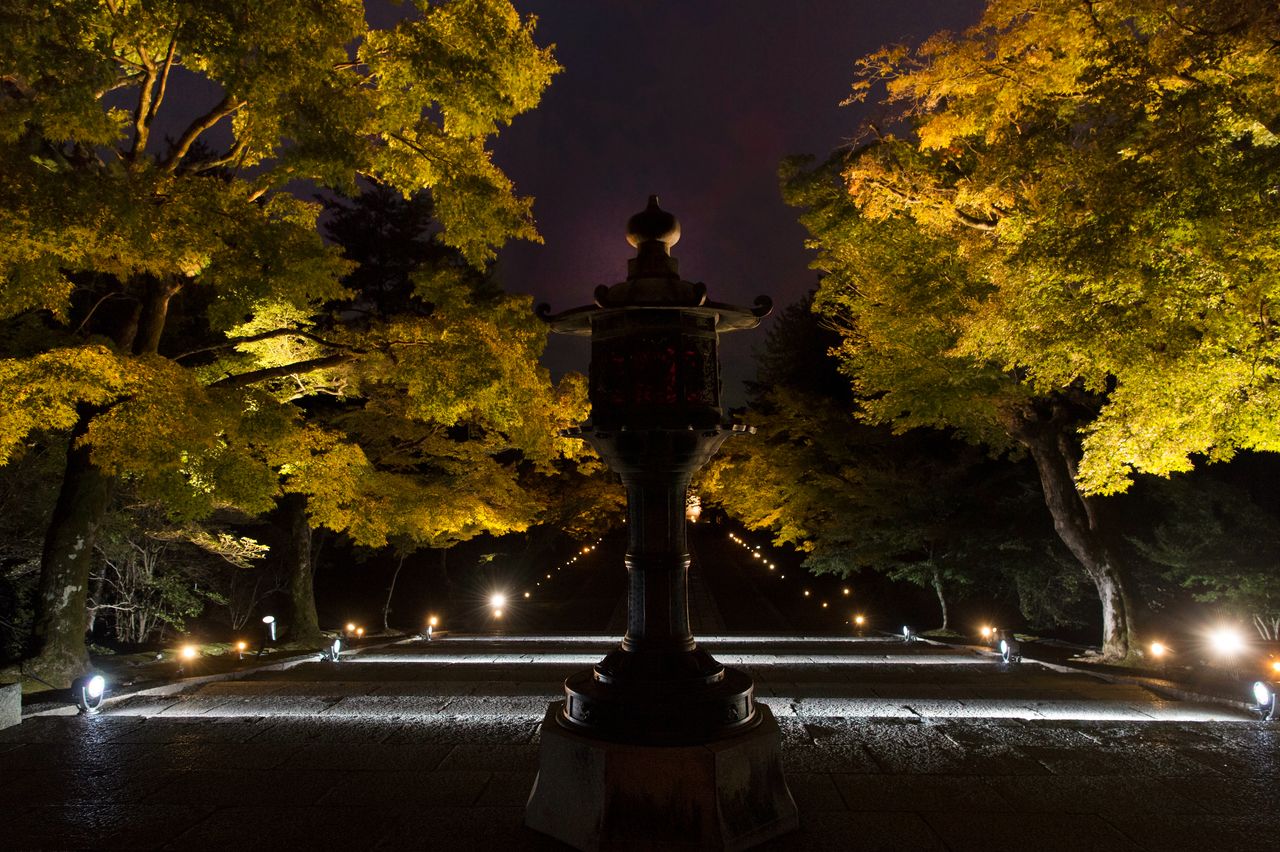
The grounds at Ninnaji, lit up at night.
Ninnaji
- Address: 33 Omuro Ōuchi, Ukyō-ku, Kyoto
- Hours: 9:00 am to 5:00 pm (last entry 30 minutes prior to closing time). Closes at 4:30 pm from December to February.
- Entrance fee: Admission to the temple grounds is free. Imperial residence: ¥500 for ages 16 and up, ¥300 for ages 6–15. Reihōkan treasure house (open for limited periods): ¥500 for adults, free for ages 16 and under. Group discounts are also available.
- Access: From JR Kyoto Station, take City Bus 26 to the Omuro Ninnaji stop, approx. 40 mins., then a short walk. Or walk approx. 3 mins. from Omuro Ninnaji Station on the Randen Kitano Line.
- Iroha Nihon official site: http://nf-iroha.jp/english/distinations/ninnaji/
(Originally published in Japanese. Photos by Kuroiwa Masakazu, 96Box. Reporting and text by Nippon.com.)
Kyoto tourism World Heritage Buddhism national treasure inn shrine and temple
